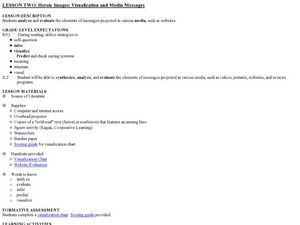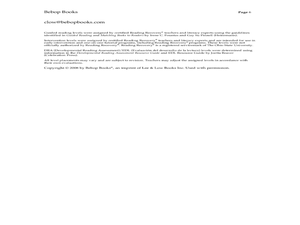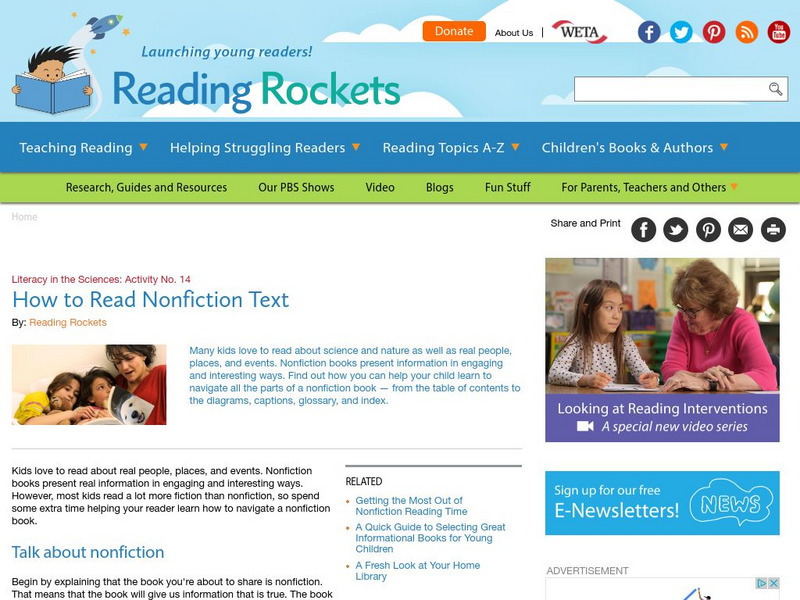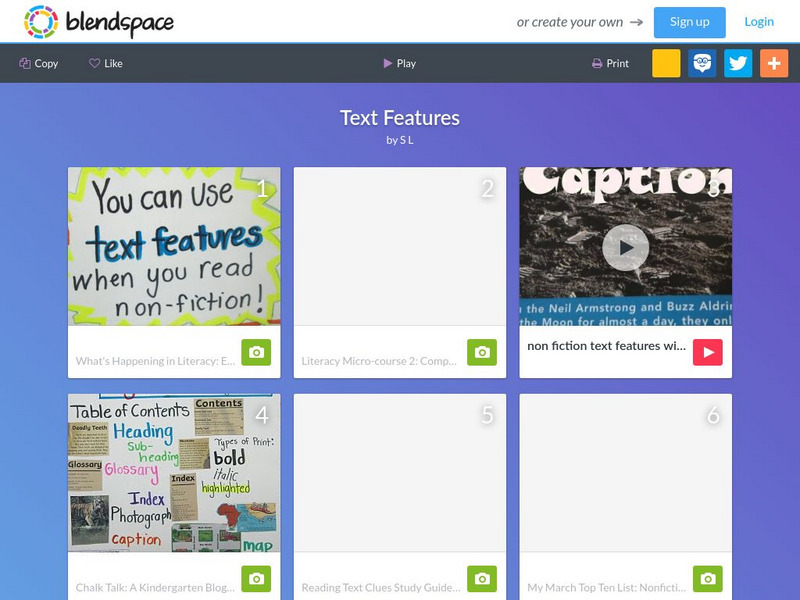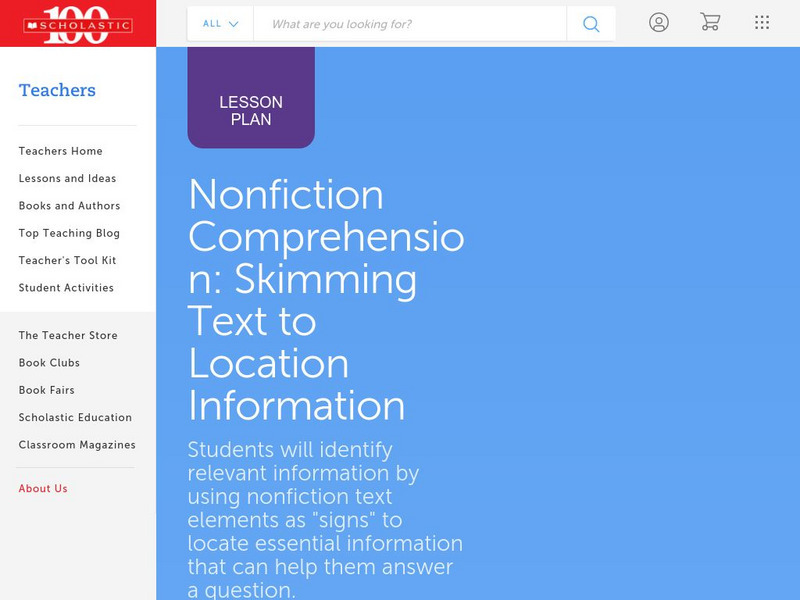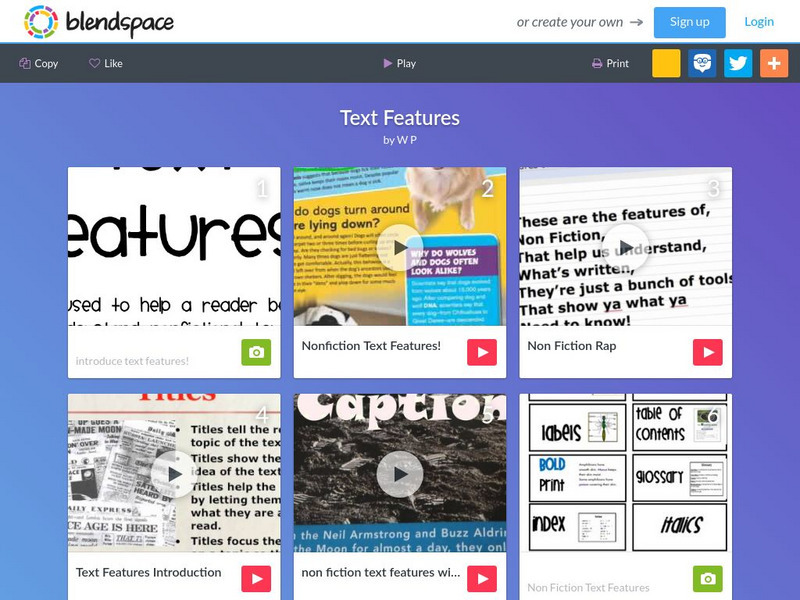Curated OER
Heroic Images: Visualization and Media Messages
Students examine media messages. In this media awareness lesson, students analyze online messages about heroism as they complete a jigsaw reading activity.
Curated OER
Diaries From the Holocaust
Sixth graders find similarities and differences in two different diary entries. In this Holocaust history meets literary skills lesson, 6th graders read the diary of a soldier or prisoner from the the Auschwitz concentration camp and...
Curated OER
Guided Reading: Shapes Where We Play
Students discover shapes on a playground. In this guided reading lesson, students discover new vocabulary words related to shapes as they read Shapes Where We Play. In small groups, students use picture clues and one to one matching to...
Curated OER
Go Go Gumbo
Students read the book, "Go Go Gumbo." After looking the front and back cover, students predict what may happen in the story. They discuss strategies for reading unfamiliar words. Students answer questions about the story. Cross...
Curated OER
Guided Reading with Hello Flower
Students are introduced to the book and vocabulary through a group discussion. They view the book cover and predict what they expect the story to be about. Students read the book orally with the class. After a discussion, they whisper...
Curated OER
Mom Is A Painter
Third graders read the book entitled, "Mom Is A Painter." After surveying the book, 3rd graders predict events in the story. They discuss strategies for decoding unfamiliar words. As a class, students discuss using paint to decorate...
Curated OER
Seeing Is Believing
Learners research and describe the stories of Thomas Jefferson, Meriwether Lewis and William Clark. They analyze historical sources from different points of view and present an analysis of two historical contexts.
Curated OER
Beneath the News: Who's Doing What to Whom, and Who Cares?
Students investigate the differences between various forms of media (print, radio, TV, Internet). They determine the target audience for each and compare exposure around the world. They write a short story and share it with the class.
Curated OER
Writing Directions for Mathematical Activities
Fifth graders reorganize comic strips to have them make sense, complete outline and organize their thoughts into outline form to explain directions,
and use that outline to complete their own directions for geometry activities.
Curated OER
Postcards from the Past
Students create postcards from the past by summarizing a historical event. Then they design illustrations for their postcards and send them off to another teacher at their school.
British Library
British Library: 19th Century Non Fiction Texts: Work & Welfare
This thematic collection will allow students to read and understand 19th-century non-fiction texts, and support them in identifying key features for a range of genres, audiences, and purposes. Each source is accompanied by original...
British Library
British Library: 19th Century Non Fiction Texts: Gender, Behaviour & Etiquette
This thematic collection will allow students to read and understand 19th-century non-fiction texts, and support them in identifying key features for a range of genres, audiences, and purposes. Each source is accompanied by original...
British Library
British Library: 19th Century Non Fiction Texts: Education
This thematic collection will allow students to read and understand 19th-century non-fiction texts, and support them in identifying key features for a range of genres, audiences, and purposes. Each source is accompanied by original...
British Library
British Library: 19th Century Non Fiction Texts: Crime & Punishment
This thematic collection will allow students to read and understand 19th-century non-fiction texts, and support them in identifying key features for a range of genres, audiences, and purposes. Each source is accompanied by original...
ReadWriteThink
Read Write Think: Comprehending Nonfiction Text on the Web
Contains plans for three lessons designed to improve comprehension of nonfiction, especially nonfiction texts on the web. It focuses on identifying text features, locating specific information, and generalizing that information. In...
Reading Rockets
Reading Rockets: How to Read Nonfiction Text
Kids love to read about real people, places, and events. Nonfiction books present real information in engaging and interesting ways. However, most kids read a lot more fiction than nonfiction, so spend some extra time helping your reader...
Other
Seeing the World in Print Through Nonfiction
Unit plan containing five lessons designed for tenth graders. They center around reading and writing nonfiction, and they teach skills such as identifying the features of nonfiction and writing expository texts. All are aligned to...
Quizlet
Quizlet: Nonfiction Text Features 3rd Grade Flashcards
Text feature terms (nonfiction) are included in this review exercise Flashcards are provided for the following words: map, table of contents, index, bold words, caption, timeline, heading, and glossary. Images of each of these text...
TES Global
Blendspace: Text Features
A six-part learning module with links to images, graphic organizers, and a video on recognizing text features in nonfiction texts.
Quizlet
Quizlet: Non Fiction Text Features 3rd Grade Test
Text feature terms are included in this assessment. This test assesses the following text feature terms: map, table of contents, index, bold words, caption, timeline, heading, and glossary. Images of the text feature terms are included....
Scholastic
Scholastic: Lesson Plan for Nonfiction Comprehension: Skimming Text
Build comprehension by developing reading strategies for use with nonfiction text. This lesson focuses on teaching students to recognize text elements as clues to help them quickly locate key information in text.
ReadWriteThink
Read Write Think: Using Science Texts to Teach the Organization of Nonfiction
Contains plans for three lessons that use science textbooks to teach about the organizational features of nonfiction such as labels, captions, headings, and fonts. In addition to objectives and standards, this instructional plan contains...
TES Global
Blendspace: Text Features
A six-part learning module with links to videos and images to use while learning about text features in a nonfiction text.
TES Global
Blendspace: Text Features
A nine-part learning module with links images and videos for use while learning about nonfiction text features.


